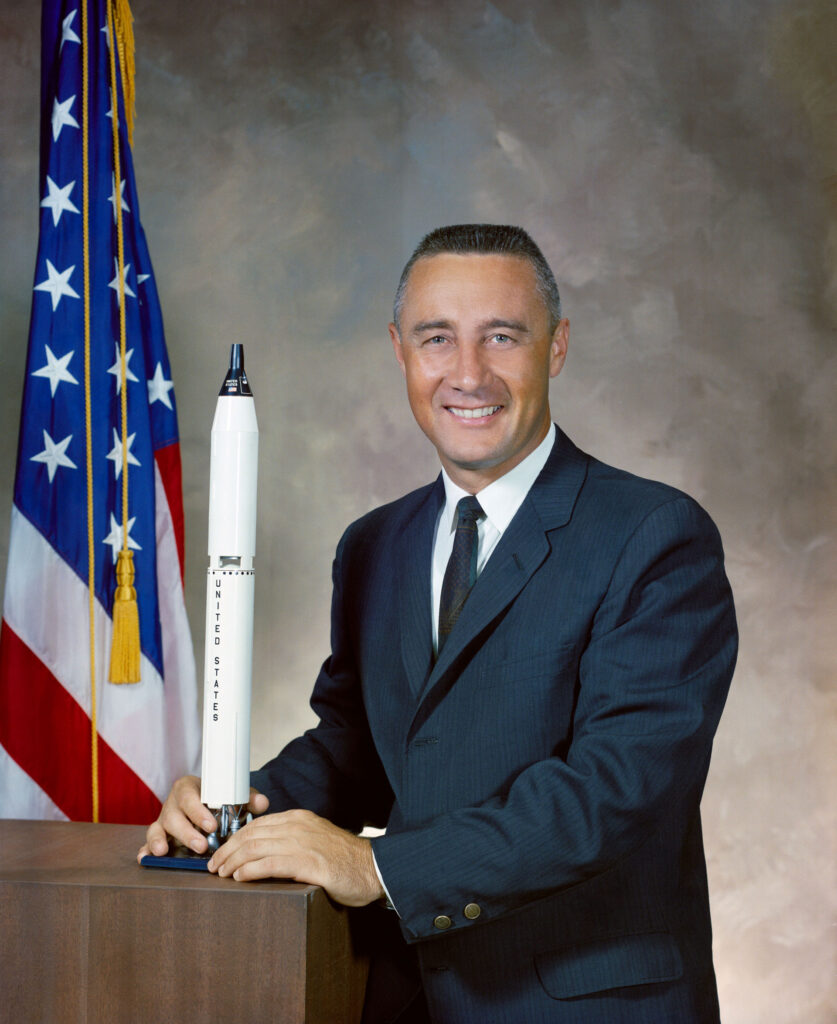The second American to travel in space; first person to enter space twice.
Virgil Ivan “Gus” Grissom was born on April 3, 1926, in Mitchell, Indiana. The son of a railroad worker, Grissom graduated from high school in Mitchell in 1944 then was an aviation cadet until he was discharged in November 1945. He graduated from Purdue University with a degree in mechanical engineering in 1950, returned to aviation cadet training and received his pilot’s wings in March 1951.
Grissom flew 100 combat missions during the Korean War, in F-86s with the 334th Fighter-Interceptor Squadron. He left Korea in June 1952 to serve as a jet pilot instructor at Bryan, Texas. In August 1955 he went to the Air Force Institute of Technology at Wright-Patterson Air Force Base (AFB), Ohio, to study aeronautical engineering. In October 1956 he attended the Test Pilot School at Edwards AFB, California and returned to Wright-Patterson in May 1957 as a test pilot assigned to the Fighter Branch. He flew more than 3400 hours, including over 2500 hours in jets.
NASA selected Gus Grissom as one of the original seven Mercury astronauts in 1959. He became the second American in space when his Liberty Bell 7 spacecraft launched from Cape Canaveral, Florida, on July 21, 1961. The successful sub-orbital flight ended approximately fifteen minutes after lift-off when Liberty Bell 7 popped its chutes and landed safely in the Atlantic Ocean.
Before Grissom and the Mercury capsule were recovered a hatch blew off prematurely and water flooded the cabin. After Grissom escaped the sinking capsule the rescue helicopter was unable to recover the spacecraft with the added weight of the water and Liberty Bell 7 sank to the bottom of the ocean. Nonetheless, it was a successful flight, corroborating Alan Shepard’s experiences, and the Mercury program could move ahead. Examination of Liberty Bell 7 after it was retrieved from the ocean floor in 1999 did not resolve the issue of how the hatch blew open but it is generally accepted Grissom himself was not responsible.
On March 23, 1965, Grissom returned to space as the commander of Gemini III, the first manned mission of the program, in a craft he had nicknamed the Molly Brown after the Broadway Musical The Unsinkable Molly Brown. Accompanied by Pilot John Young, Grissom became the first person to enter space twice. The main objectives for the five-hour flight were to test all of the major operating systems and to determine if controlled maneuvering of the spacecraft was possible. Being able to change orbit and flight path was crucial to upcoming rendezvous missions, and Grissom successfully executed orbital maneuvers in space. Molly Brown splashed down after flying eighty thousand miles in three successful orbits around the earth.
In March 1966, NASA announced that Grissom would command Apollo/Saturn 204, the first Earth-orbit mission of the program that was to take a man to the moon. Edward White (the first American to walk in space) would serve as Senior Pilot and Roger Chaffee was named Pilot. Due to serious issues with the Apollo spacecraft the initial launch date in the last quarter of 1966 was postponed by several weeks. After more redesigning, the crew capsule, Spacecraft 012, was taken to Kennedy Space Center, Florida for final preflight tests. On January 27, 1967, during a lengthy “plugs out” test on the launch pad, Lieutenant Colonel Virgil Ivan “Gus” Grissom and his crew were killed in flash fire that roared through the capsule when the pure oxygen used in the spacecraft was ignited by a spark. At the request of his widow, Mrs. Betty Grissom, the Apollo/Saturn 204 mission was renamed Apollo 1.
Virgil Grissom was posthumously awarded the Congressional Space Medal of Honor in 1978. Marina Grissom (a landmark on the moon) and asteroid 2161 Grissom are named in his honor. It has been speculated that if not for the Apollo 1 fire, Grissom would have been NASA’s first choice to command the first lunar landing. During his lifetime he was awarded the Distinguished Flying Cross and the Air Medal with the cluster for his Korean service, two NASA Distinguished Service Medals, the NASA Exceptional Service Medal, and the Air Force Command Astronaut Wings.

